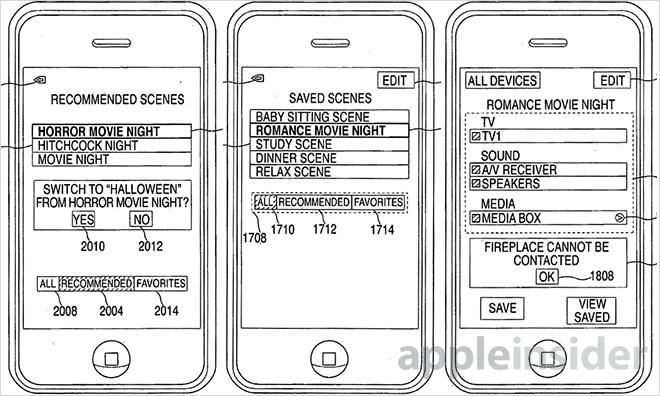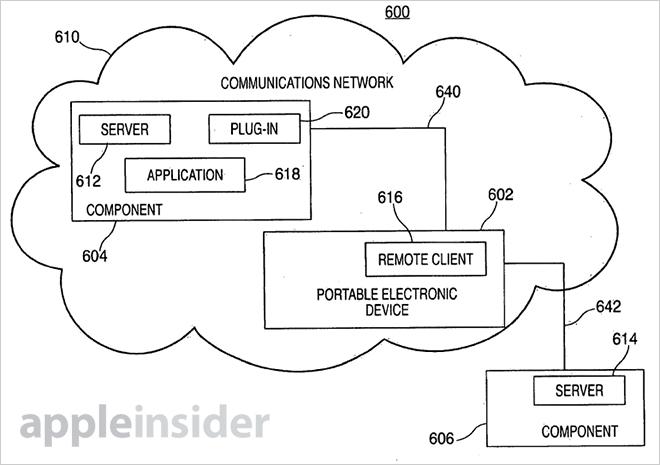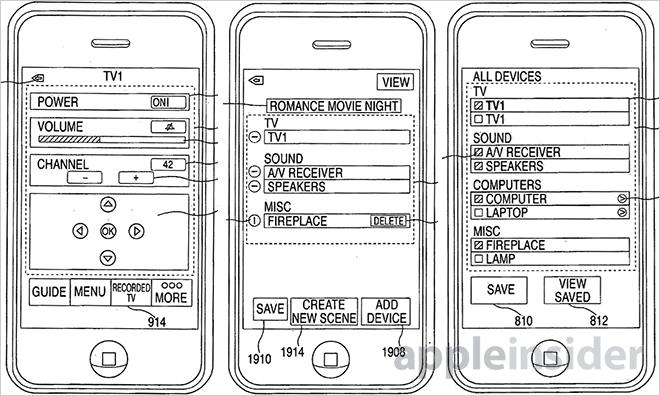An Apple patent published by the U.S. Patent and Trademark Office on Tuesday describes a method in which a portable device, like the iPhone, can save, manage and recall entertainment and "smart home" system settings, called "scenes."
Apple's U.S. Patent No. 8,519,820 for "Systems and methods for saving and restoring scenes in a multimedia system" was first filed for five years ago by the developer who coded the first iTunes Remote iOS app, Alan Cannistraro.
While Remote has become a powerful app that controls not only an iTunes library, but the Apple TV as well, Cannistraro's scene capturing patent is on a completely different level. What Apple proposes is a software driven intelligent universal remote that can connect to multiple A/V components, as well as "smart home" devices like lights and window shades, via Wi-Fi, Bluetooth or other wireless protocol.
As noted in the document, regular universal remote controls allow for scene selections, such as "play game" or "movie," but the devices are unable to intelligently suggest television, stereo or lighting settings. In addition, users must first set up what components are in the entertainment system, specify the settings for each "scene" and finally activate said scene.
To ease the burden of manually configuring the remote, the portable device receives information broadcast from separate components regarding their operating states. For example, the volume and fade settings from an amplifier can sent to the device and saved for later retrieval. Both software and hardware settings are supported, including what media is playing. Scenes can be adjusted as necessary and users can select their own saved scenes or create new sets via a common user interface.
Further, the system can detect usage patterns and metadata associated with a certain scene, offering settings recommendations when appropriate. As for usage patterns, the system can track the times and frequency that a saved scene is accessed. For example, when a user turns on the multimedia system on a Saturday, the system will search for and recommend a scene that is frequently accessed at that time on that day.
For metadata, the system can detect identifiers like "horror movie" or the name of a song, then search saved scene data for a settings list that best suits the genre. Users have the option to accept or deny the recommendation.
In some embodiments, the system allows users to stop and restart media when they move from one position in their home to another. If, for example, a horror movie is playing on one television and a user moves to another television, the system can recognize the switch and recommend playback be restarted from a selected scene. This swap changes the scene at the second television, from the point at which the media stopped to component specific hardware and software settings.
In yet another embodiment, the system can wait until a commercial break is detected to display scene recommendations.
While the remote control method would be helpful for many iOS device users, the possibility of its implementation remains uncertain. To operate efficiently, each component, including the television, must be able to broadcast identifier settings, as well as receive and respond to signals over a wireless network. The patent language notes wireless bridges can be used between connected devices and those without access, though compatibility may be an issue for older hardware.
Cannistraro first filed for the universal remote patent in September 2008, but much of the technology described has yet to make its way to an Apple device.
 Mikey Campbell
Mikey Campbell









-m.jpg)






 William Gallagher
William Gallagher
 Christine McKee
Christine McKee
 Malcolm Owen
Malcolm Owen
 Marko Zivkovic
Marko Zivkovic

 Andrew Orr
Andrew Orr
 Andrew O'Hara
Andrew O'Hara





-m.jpg)


17 Comments
my roomate's step-aunt makes $73/hr on the laptop. She has been unemployed for seven months but last month her income was $20978 just working on the laptop for a few hours. Go to this web site and read more>>>>> www.Day34.com
dsvg
Software patents like this are bad.
Software patents like this are bad.
You know what they say.. "Neccessity is the mother of all inventions".
There were days when Apple chose to be more light on what to patent and what not to.
Ever since they realized the cunning cloning foxes out there, enjoying the fruits of there work, it leaves them no option but to patent everything from A-Z.
This in turn will push the industry to do some of there own innovation. Which in the end will be good for everyone.
Software patents like this are bad.
Patents are NOT dead ends.
Each patent is just a way among zillions of doing A thing.
It is the ’’market’’ that decides which is The Best, which is The Cheapest.
There are always plenty of ways of doing anything.
The patent system was the basis of the Industrial revolution, without it no one would have invested on ideas, and those with big money would have always won.
To patent an idea is one thing, buying patents to blackmail people is another thing.